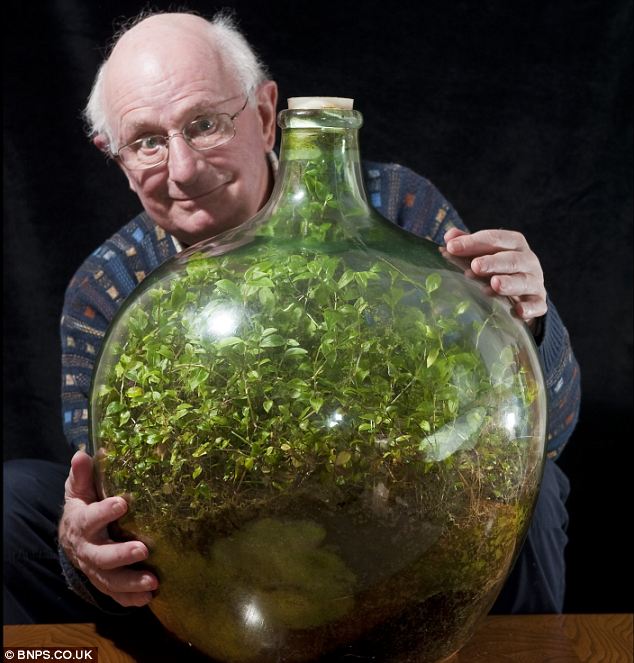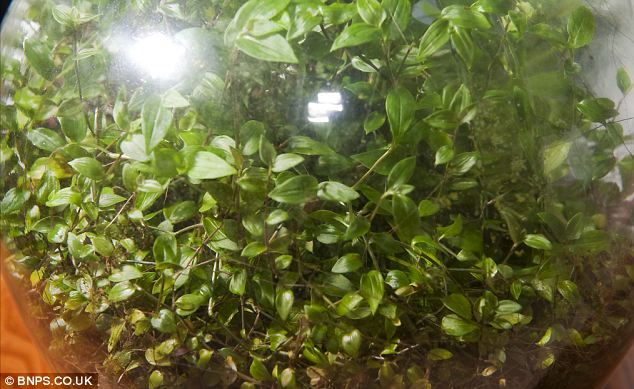To look at this flourishing mass of plant life you’d think David Latimer was a green-fingered genius.
Truth be told, however, his bottle garden – now almost in its 54rd year – hasn’t taken up much of his time.
In fact, on the last occasion he watered it Ted Heath was Prime Minister and Richard Nixon was in the White House!
(Scroll down for video)

For the last 40 years it has been completely sealed from the outside world. But the indoor variety of spiderworts (or Tradescantia, to give the plant species its scientific Latin name) within has thrived, filling its globular bottle home with healthy foliage.
Yesterday Mr Latimer, 80, said: ‘It’s 6ft from a window so gets a bit of sunlight. It grows towards the light so it gets turned round every so often so it grows evenly.
‘Otherwise, it’s the definition of low-maintenance. I’ve never pruned it, it just seems to have grown to the limits of the bottle.’
The bottle garden has created its own miniature ecosystem. Despite being cut off from the outside world, because it is still absorbing light it can photosynthesise, the process by which plants convert sunlight into the energy they need to grow.

See also: According To NASA There Are 9 Houseplants That Clean The Air Which Are Almost Impossible To Kill!
HOW THE BOTTLE GARDEN GROWS
Bottle gardens work because their sealed space creates an entirely self-sufficient ecosystem in which plants can survive by using photosynthesis to recycle nutrients.
The only external input needed to keep the plant going is light, since this provides it with the energy it needs to create its own food and continue to grow.
Light shining on the leaves of the plant is absorbed by proteins containing chlorophylls (a green pigment).
Some of that light energy is stored in the form of adenosine triphosphate (ATP), a molecule that stores energy. The rest is used to remove electrons from the water being absorbed from the soil through the plant’s roots.
These electrons then become ‘free’ – and are used in chemical reactions that convert carbon dioxide into carbohydrates, releasing oxygen.
This photosynthesis process is the opposite of the cellular respiration that occurs in other organisms, including humans, where carbohydrates containing energy react with oxygen to produce carbon dioxide, water, and release chemical energy.
But the eco-system also uses cellular respiration to break down decaying material shed by the plant. In this part of the process, bacteria inside the soil of the bottle garden absorbs the plant’s waste oxygen and releasing carbon dioxide which the growing plant can reuse.
And, of course, at night, when there is no sunlight to drive photosynthesis, the plant will also use cellular respiration to keep itself alive by breaking down the stored nutrients.
Because the bottle garden is a closed environment, that means its water cycle is also a self-contained process.
The water in the bottle gets taken up by plants’ roots, is released into the air during transpiration, condenses down into the potting mixture, where the cycle begins again.
Photosynthesis creates oxygen and also puts more moisture in the air. The moisture builds up inside the bottle and ‘rains’ back down on the plant.
The leaves it drops rot at the bottom of the bottle, creating the carbon dioxide also needed for photosynthesis and nutrients which it absorbs through its roots.
It was Easter Sunday 1960 when Mr Latimer thought it would be fun to start a bottle garden ‘out of idle curiosity’.
He said: ‘At the time the chemical industry had changed to transporting things in plastic bottles so there were a lot of glass ones on the market.
‘Bottle gardens were a bit of a craze and I wanted to see what happened if you bunged the thing up.’
Must see: Julia Roberts Taught Me More In Less Than 2 Minutes Than Anyone Else Has Done My WHOLE Life! [Video]
Originally taken from Daily Mail
